Day 3 of a long weekend of tours today. The plan was to spend the morning inland, looking for raptors and farmland birds, and then drop down to the coast in the afternoon. We wanted to make the most of the dry weather in the morning, and then take advantage of shelter provided by the hides at Titchwell later on as the forecast rain arrived.
We began with a drive inland from the coast. It was already a bit cool and cloudy this morning, and raptor activity was a little subdued as a consequence. The highlight of the journey today was a family party of Grey Partridge in the road in front of us. One of the adults was shepherding a large group of juveniles – at least 14! – along the tarmac. They seemed unsure which way to go as we approached, and the youngsters scattered into the verges on either side. Finally the other adult appeared from the long grass, and between the two of them the grown-ups shepherded their flock into the safety of the hedge.
Once again, we stopped by one of our favourite tracks and set off to explore. A male Yellowhammer was singing from the hedge beside the path as we set off, a real sound of farmland. The family of Whitethroats were calling, but remained mostly tucked down in the shelter of the hedge. A family of Blue Tits flew along the hedge ahead of us.
There were fewer butterflies along the overgrown verge than in recent weeks, probably due to the recent cold and wet weather. However, we still saw several Ringlets and Meadow Browns amongst the grass. The hogweed flowers were still alive with Soldier Beetles and a Bloody-nosed Beetle plodded slowly across the path. A rather large Common Toad was hiding in one of the damp wheel ruts.
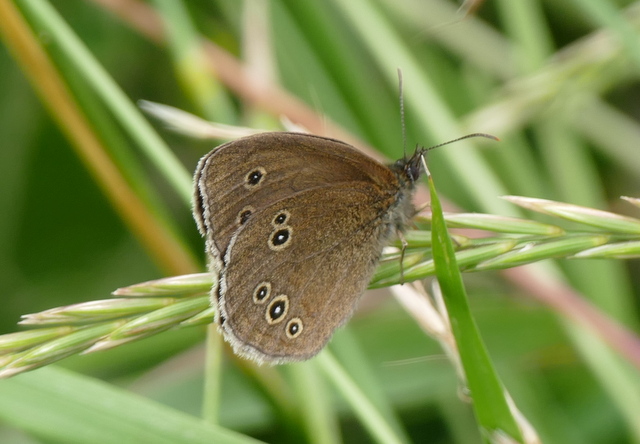 Ringlet – still several out today, despite the cool conditions
Ringlet – still several out today, despite the cool conditions
As we rounded a corner of the path, into an area where the hedges are thick and tall on either side, we could hear the delicate piping contact call of Bullfinches. Generally secretive, they can be very hard to see at this time of year, but a female Bullfinch perched up briefly in the tops of some dead trees ahead of us. There were lots of other finches in this overgrown section of the path as well. Several Chaffinches flew up from the path and more scattered from the brambles as we walked along. We could Goldfinches and Linnets calling from the tops of the hedges as well.
We stopped on the higher ground where we had a good view of the surrounding countryside. At first it was rather quiet. A Brown Hare appeared in the stubble and ran across in front of us. When it stopped, a second pair of ears appeared next to it. The two Hares fed for a while, before they set off on a chase, the female in front dinking from side to side with the male following – more like Mad July Hares! There was no boxing today and eventually the female Hare stopped and allowed the male to mate with her – Brown Hares have a very long breeding season.
 Brown Hares – feeding in the stubble before the chase
Brown Hares – feeding in the stubble before the chase
There was a good selection of raptors today, but it was a little slower than in warmer weather. Eventually a couple of Buzzards circled up in the distance but did not get very high. A mewing call behind us alerted us to one behind us, but it just skimmed the treetops and dropped back down. A Kestrel or two flew round over the stubble. Later, on the way back by the car, one of the Kestrels hovered over the path ahead of us. In the meadow nearby, a couple of recently fledged juvenile Kestrels were sitting on the wires.
While we were scanning for raptors, a large mixed flock of Rooks and Jackdaws had flown in and dropped down to feed in the stubble. Back at the paddocks, there were several more Rooks feeding close to the road. As the breeding season comes to a close, they seem to be wandering more widely again now.
 Rook – several were feeding in the paddocks today
Rook – several were feeding in the paddocks today
From there, we headed up towards the coast via Choseley. A little detour round the back lanes and two Corn Buntings flew out of the hedge in their usual place as we approached. However, rather than coming back out onto the hedge today, they landed out in the barley. There were a couple of Yellowhammers on the wires round by the drying barns, as well as several Chaffinches. While we were scanning the fields, we could hear another Corn Bunting singing further off.
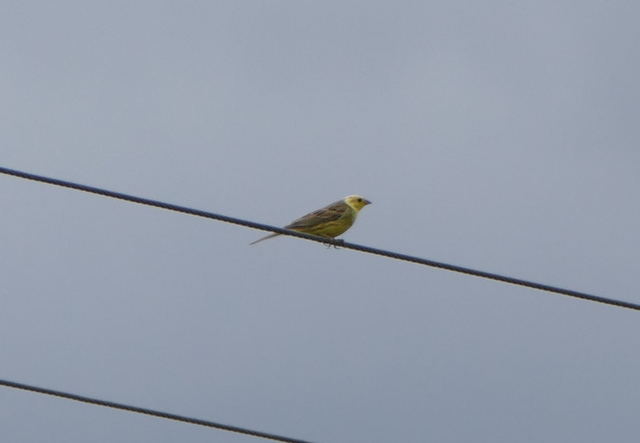 Yellowhammer – a couple were obliging, on the wires at Choseley
Yellowhammer – a couple were obliging, on the wires at Choseley
Otherwise, it was fairly quiet around the barns. A Collared Dove flew in and landed on the wires. The next thing we knew, more had appeared and eventually there were six together, but no sign of any Turtle Doves. A Stock Dove perched on the top of a telegraph post, singing. Looking to the south west, we could see dark grey clouds approaching, so we headed down to Titchwell for an early lunch. Thankfully the worst of the clouds passed overhead while we were eating – it started spitting with rain, but it was not too bad.
 Choseley – dark grey clouds arriving from the south west
Choseley – dark grey clouds arriving from the south west
After lunch, we walked out across the reserve. We stopped briefly by the reedbed pool to scan through the ducks. There were three Red-crested Pochard out on the water, an eclipse male with coral red bill and two darker billed females. There were also a couple of Common Pochard, plus a selection of dabbling ducks – Gadwall, Teal, Shoveler. However, with light rain still falling, we made a beeline for the shelter of Island Hide.
The water level on the freshmarsh was up considerably on recent weeks – not a great surprise after the deluge the last couple of days. However, there was still an amazing number of Avocet present. A quick count suggested about 400 birds! An impressive sight.
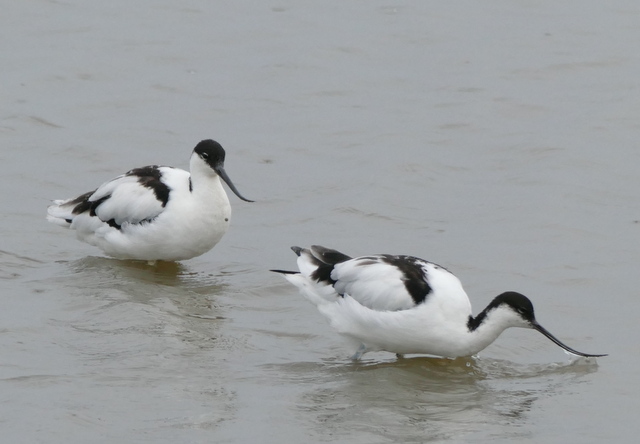 Avocet – still around 400 present at Titchwell
Avocet – still around 400 present at Titchwell
A little group of Black-tailed Godwits was feeding right in front of the hide, a mixture of bright rusty orange moulting adults and greyer 1st summer birds. Further out, a larger group of godwits roosting on the edge of the islands proved to be Bar-tailed Godwits, presumably sleeping here over the high tide. One or two Black-tailed Godwits amongst them provided the opportunity to compare the two species side by side.
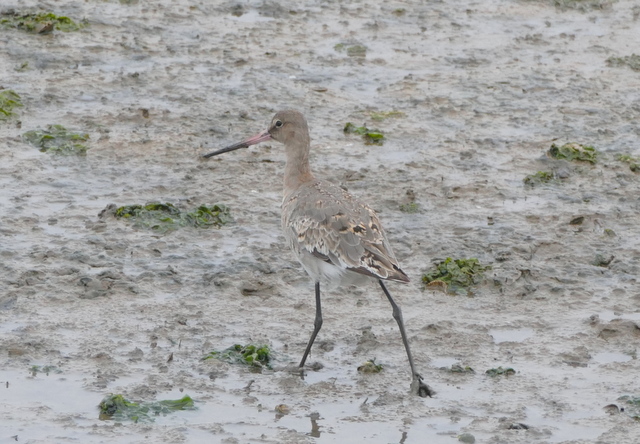 Black-tailed Godwit – still several on the freshmarsh and Volunteer Marsh
Black-tailed Godwit – still several on the freshmarsh and Volunteer Marsh
There were also still a good number of Ruff around the freshmarsh. Several of the males were now well advanced in the moult to non-breeding plumage, but others were still splashed with various more extensive patches of black or chestnut, the remnants of breeding plumage.
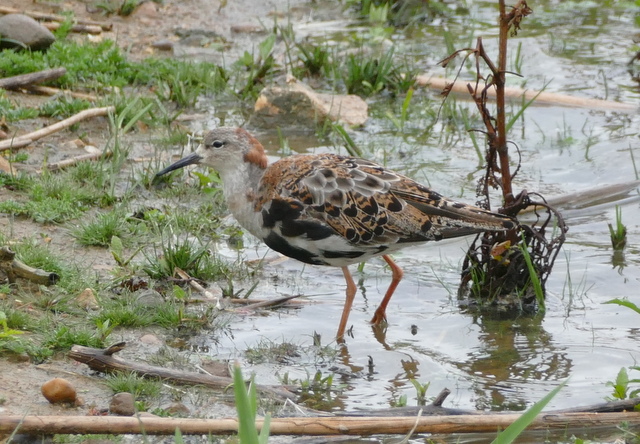 Ruff – a male in the middle of moulting out of breeding plumage
Ruff – a male in the middle of moulting out of breeding plumage
While we were watching a couple of Ruff on the mud next to the hide, a small long-tailed shape appeared amongst the bases of the reeds behind them. A juvenile Bearded Tit, we got it in the scope and got a great view of it feeding around the mud.
There were not so many smaller waders today, with less exposed mud on which to feed. A single Dunlin flew in and landed on the mud near the hide briefly. Its streaky belly revealed it to be a juvenile, lacking the defined black belly patch of the adults at this time of year. Later, from out at the Parrinder Hide, a few more Dunlin appeared out in the open when all the waders were spooked, but only about 5-6 in total today. A single Common Sandpiper appeared briefly, working its way round the shore of one of the islands towards the back of the freshmarsh.
 Little Gull – still two 1st summer birds on the freshmarsh
Little Gull – still two 1st summer birds on the freshmarsh
There were plenty of gulls loafing about on the islands today, lots of Black-headed Gulls, Herring Gulls and a couple of Lesser Black-backed Gulls. Hiding in amongst the vegetation on one of the islands, two Little Gulls were preening, both 1st summer birds, though now gradually moulting into their 2nd winter plumage. There were also several Common Terns as usual, flying around noisily or standing on the islands, and a single Sandwich Tern resting with the gulls.
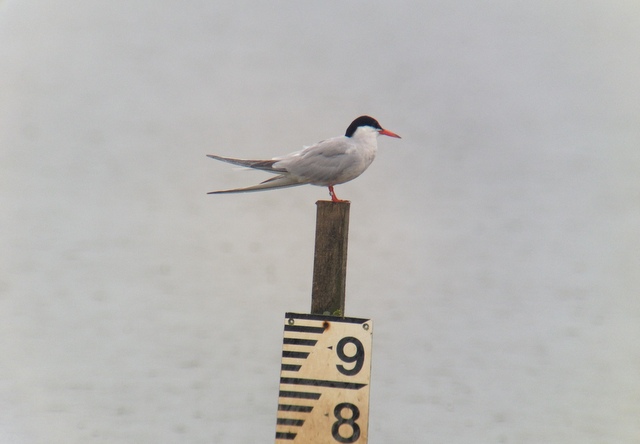 Common Tern – checking the water level on the freshmarsh
Common Tern – checking the water level on the freshmarsh
Two larger white shapes amongst the waders were a couple of Spoonbills. As usual, they were hard at work on their favourite activity – sleeping. They barely woke while we were there! Round at Parrinder Hide, three more Spoonbills came in from the direction of Brancaster. They drifted over the freshmarsh but didn’t land, heading off in the direction of the saltmarsh at Thornham.
 Spoonbills – these two remained pretty much constantly asleep
Spoonbills – these two remained pretty much constantly asleep
The rain was never particular hard, but for a while it pretty much stopped, so we took the opportunity to walk round to Parrinder Hide. On the way, we found a very obliging Spotted Redshank, feeding around the vegetation in the water just beside the main path. It was a moulting adult, and had already lost much of its blacker summer feathers. Up close, we could see the remaining ones amongst the silvery grey winter upperpart feathers and white underparts. We noted the long, needle-fine bill with a slight downward kink right at the tip.
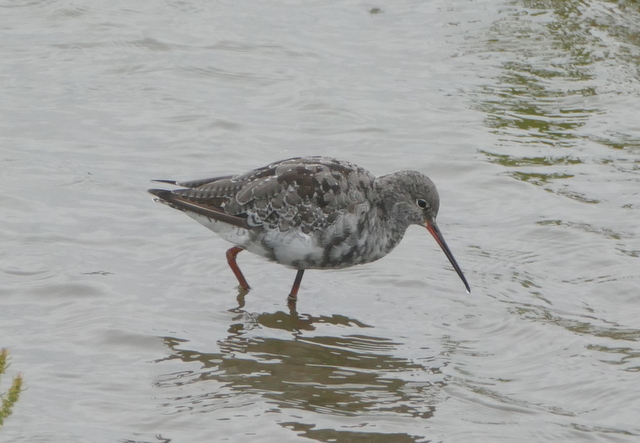 Spotted Redshank – this one well advanced in its moult to winter plumage
Spotted Redshank – this one well advanced in its moult to winter plumage
From round at the Parrinder Hide, we added a couple more waders to the day’s list. A couple of Little Ringed Plovers were feeding along the drier edge of the freshmarsh. A Common Snipe appeared from the vegetation below the bank and we got a great view of it working its way along, probing into the mud with its long bill. While we were there, a couple of Chinese Water Deer appeared briefly from the reeds opposite, an adult with a well grown fawn.
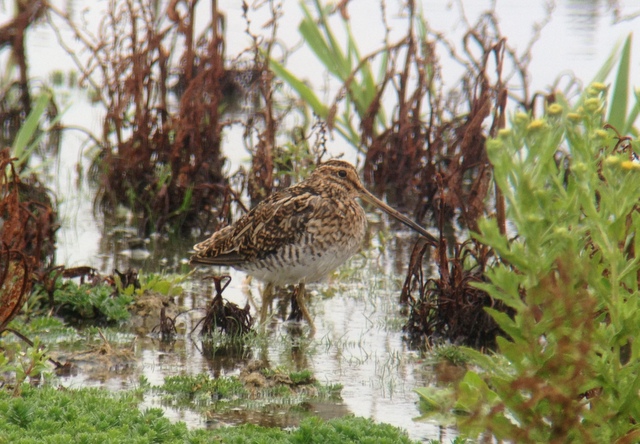 Common Snipe – feeding in the vegetation by the bank next to Parrinder Hide
Common Snipe – feeding in the vegetation by the bank next to Parrinder Hide
The Volunteer Marsh has been very quiet in recent weeks, but there was a little more activity on here today, possibly due to the high tide offshore and the higher water level on the freshmarsh. There were several Redshanks and Black-tailed Godwits, mostly clustered along the main tidal channel. A Little Egret was fishing in the shallows by the path. We watched it paddling with its feet ahead of it, trying to disturb prey from the surface of the mud. It appeared to be working as it caught what appeared to be a small fish.
 Little Egret – fishing in the channel on the Volunteer Marsh
Little Egret – fishing in the channel on the Volunteer Marsh
The weather still wasn’t too bad and we were feeling adventurous, so we headed out to the beach. The tide was in, but the storms of yesterday had resulted in a wreck of razor shells along the beach. This was heaving with gulls, taking advantage of the bounty. Amongst them, we could also see several Turnstone, still resplendent in mostly summer plumage, a scattering of Sanderling, Bar-tailed Godwits and quite a few Oystercatchers. The sea itself was rather quiet, apart from a couple of Sandwich Terns and a distant flock of Common Scoter flying past.
Given the forecast this morning, we had been remarkably lucky with the weather today. However, finally the rain started to pick up again, so we turned to head back. We did manage a quick detour round via Patsy’s Reedbed on our way back. It was well worth it, as we picked out a single Garganey amongst the ducks, its boldly patterned face giving it away. Then it was time to call it a day and head for shelter.
















